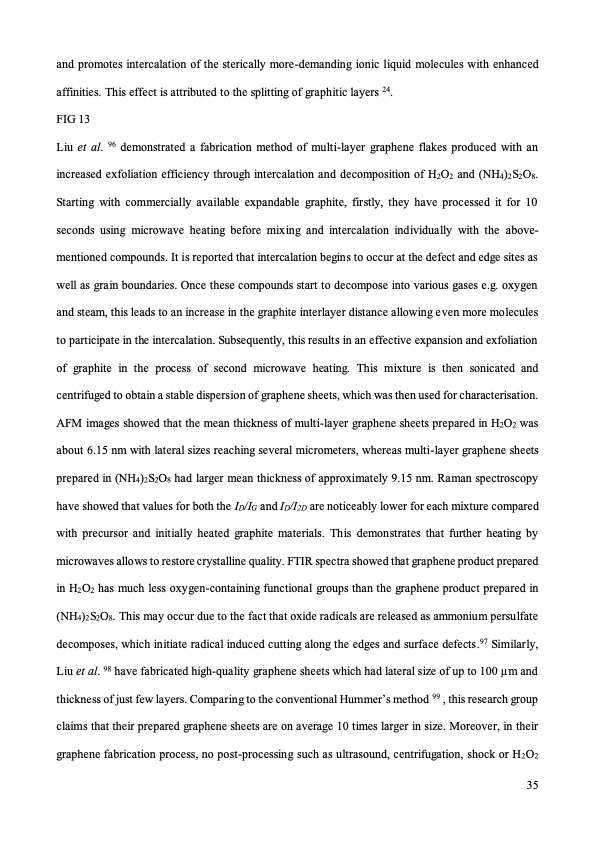PDF Publication Title:
Text from PDF Page: 035
and promotes intercalation of the sterically more-demanding ionic liquid molecules with enhanced affinities. This effect is attributed to the splitting of graphitic layers 24. FIG 13 Liu et al. 96 demonstrated a fabrication method of multi-layer graphene flakes produced with an increased exfoliation efficiency through intercalation and decomposition of H2O2 and (NH4)2S2O8. Starting with commercially available expandable graphite, firstly, they have processed it for 10 seconds using microwave heating before mixing and intercalation individually with the above- mentioned compounds. It is reported that intercalation begins to occur at the defect and edge sites as well as grain boundaries. Once these compounds start to decompose into various gases e.g. oxygen and steam, this leads to an increase in the graphite interlayer distance allowing even more molecules to participate in the intercalation. Subsequently, this results in an effective expansion and exfoliation of graphite in the process of second microwave heating. This mixture is then sonicated and centrifuged to obtain a stable dispersion of graphene sheets, which was then used for characterisation. AFM images showed that the mean thickness of multi-layer graphene sheets prepared in H2O2 was about 6.15 nm with lateral sizes reaching several micrometers, whereas multi-layer graphene sheets prepared in (NH4)2S2O8 had larger mean thickness of approximately 9.15 nm. Raman spectroscopy have showed that values for both the ID/IG and ID/I2D are noticeably lower for each mixture compared with precursor and initially heated graphite materials. This demonstrates that further heating by microwaves allows to restore crystalline quality. FTIR spectra showed that graphene product prepared in H2O2 has much less oxygen-containing functional groups than the graphene product prepared in (NH4)2S2O8. This may occur due to the fact that oxide radicals are released as ammonium persulfate decomposes, which initiate radical induced cutting along the edges and surface defects.97 Similarly, Liu et al. 98 have fabricated high-quality graphene sheets which had lateral size of up to 100 μm and thickness of just few layers. Comparing to the conventional Hummer’s method 99 , this research group claims that their prepared graphene sheets are on average 10 times larger in size. Moreover, in their graphene fabrication process, no post-processing such as ultrasound, centrifugation, shock or H2O2 35PDF Image | graphene production via nonoxidizing liquid exfoliation

PDF Search Title:
graphene production via nonoxidizing liquid exfoliationOriginal File Name Searched:
Graphene-R2-review.pdfDIY PDF Search: Google It | Yahoo | Bing
Salgenx Redox Flow Battery Technology: Power up your energy storage game with Salgenx Salt Water Battery. With its advanced technology, the flow battery provides reliable, scalable, and sustainable energy storage for utility-scale projects. Upgrade to a Salgenx flow battery today and take control of your energy future.
CONTACT TEL: 608-238-6001 Email: greg@infinityturbine.com (Standard Web Page)